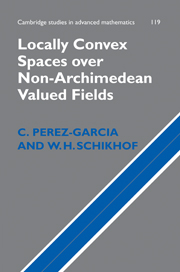Book contents
- Frontmatter
- Contents
- Preface
- 1 Ultrametrics and valuations
- 2 Normed spaces
- 3 Locally convex spaces
- 4 The Hahn–Banach Theorem
- 5 The weak topology
- 6 C-compactness
- 7 Barrelledness and reflexivity
- 8 Montel and nuclear spaces
- 9 Spaces with an “orthogonal” base
- 10 Tensor products
- 11 Inductive limits
- Appendix A Glossary of terms
- Appendix B Guide to the examples
- Notation
- References
- Index
9 - Spaces with an “orthogonal” base
Published online by Cambridge University Press: 06 July 2010
- Frontmatter
- Contents
- Preface
- 1 Ultrametrics and valuations
- 2 Normed spaces
- 3 Locally convex spaces
- 4 The Hahn–Banach Theorem
- 5 The weak topology
- 6 C-compactness
- 7 Barrelledness and reflexivity
- 8 Montel and nuclear spaces
- 9 Spaces with an “orthogonal” base
- 10 Tensor products
- 11 Inductive limits
- Appendix A Glossary of terms
- Appendix B Guide to the examples
- Notation
- References
- Index
Summary
In this chapter we study locally convex spaces E having an “orthogonal” base e1, e2, … (9.1.1). We first show that for such E, (weak) sequential completeness, quasicompleteness and completeness are equivalent (9.1.6). E may have closed subspaces and quotients without an “orthogonal” base (9.2.5). We characterize bounded and compactoid sets in E in terms of e1, e2, … (9.2.7) and show that compactoids are metrizable (9.2.9(i)). E is semi-Montel if and only if E′b has an “orthogonal” base (9.2.13). We also characterize semi-Montelness (9.2.15) and nuclearity (9.2.16) in terms of properties of the base.
Every infinite-dimensional Fréchet space contains an infinite-dimensional closed subspace with an “orthogonal” base (9.3.5).
Section 9.4 is a stepping stone for the sequel; here we introduce the perfect sequence spaces and the normal topology in the spirit of the classical spaces of Köthe ([144], 6.30). We prove that it is the class of the spaces E with an “orthogonal” base for which E is weakly sequentially complete and E′ is weakly* sequentially complete (9.4.10).
In Section 9.5 we start with an infinite matrix B of nonnegative real numbers and associate to it a perfect sequence space Λ0(B) in a natural way (9.5.2, 9.5.9); we show that the class of these Λ0(B) is precisely the class of all Fréchet spaces with an “orthogonal” base (9.5.12). This fact turns out to be very useful; it enables us in Section 9.6 to translate (semi-)Montelness and nuclearity into concrete properties of the matrix B (9.6.2, 9.6.3).We apply this in Section 9.7 to spaces of analytic functions for which we prove properties that have been postponed in previous chapters (9.7.5).
Information
- Type
- Chapter
- Information
- Locally Convex Spaces over Non-Archimedean Valued Fields , pp. 337 - 372Publisher: Cambridge University PressPrint publication year: 2010
